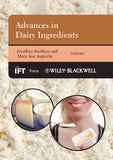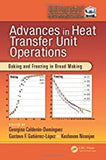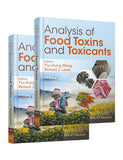Introductory Food Chemistry
John W. Brady
-
Hardcover: 656 pages
-
Publisher: Comstock Publishing Associates (3 June 2013)
Food chemistry is the study of the underlying properties of foods and food ingredients. It seeks to understand how chemical systems behave in order to better control them to improve the nutritional value, safety, and culinary presentation of food. John W. Brady's comprehensive full-color textbook provides a key resource for students of the field.
Designed for undergraduate and beginning graduate level courses, Introductory Food Chemistry explores traditional topics that students need to understand if they are to pursue careers in food in either academia or industry as well as many new and current topics not covered in other textbooks. These topics include mad cow disease, foods contaminated with melamine, acrylamide in baked foods, wine chemistry, allergens, genetically modified foods, as well as current understanding of dietary cholesterol, high fructose corn syrups, and artificial sweeteners.
Authored by one of the leading scholars in the field, Introductory Food Chemistry deploys the most current understanding of the relationship between molecular structure and function for food proteins, carbohydrates, and lipids. The book also makes critical use of color figures that illustrate food transformations visually in three dimensions rather than relying on dry equations alone.
TABLE OF CONTENTS :
Preface
1. Food Chemistry: An Introduction
What Is Food Chemistry?
Basic Review
Atoms and Molecules
Carbon
Hydrogen
Oxygen
Nitrogen
Phosphorous
Halogens
Transition Metals
Review of Thermodynamics
The First Law of Thermodynamics
Entropy and the Second Law of Thermodynamics
Suggested Reading
2. Water in Foods
Physical Properties of Water
Molecular Structure and Hydrogen Bonding
Hydrogen Bonds
Types of Hydrogen Bonds in Biological and Food Molecules
Hydrogen Bonds in Water: Ice and Liquid Water
Aqueous Solutions
Solutions with Multiple Solutes: The Hofmeister Series
Solutions of Gases in Liquids: Carbonated Beverages
Water Activity and Mobility
Food Glasses
Freezing and Freeze-Drying
Ice Nucleation and Growth
Suggested Reading
3. Dispersed Systems: Food Colloids
Colloids and Types of Dispersions
Gels
Emulsions
The Importance of Surface Area
The Thermodynamics of Surfaces
The "Mentos Eruption"
Curved Surfaces, the Kelvin Equation, and Ostwald Ripening
Antifreeze Proteins and Ice Nucleating Proteins
Adsorption at Liquid Surfaces
Adsorption at Solid Surfaces
Hysteresis in Moisture Sorption Isotherms
Producing Emulsions
HLB Numbers
Emulsion Stability
Solvation Forces
DLVO Theory
Steric Stabilization
Effects of Dissolved Polymers on Emulsion Stability
Sedimentation and Creaming
Foams
Suggested Reading
4. Carbohydrates
Carbohydrates in Foods
Carbohydrate Structures
The D-Aldoses
The D-Ketoses
Systematic Nomenclature
Carbohydrate Rings
The Relationship between D- and L-Sugars
Tautomerization
Sugar Derivatives
Reactions of Carbohydrates
Acid-Catalyzed Reactions
Reactions under Basic Conditions
Non-Oxidative Browning
Functional Properties
Sweetness
Water Binding and Solubility
Polysaccharides
Homopolymers
Heteropolymers
Suggested Reading
5. Proteins
Proteins in Foods
Polypeptide Chains
Amino Acids
Amino Acid Configurations and Taste; MSG
Aspartame
Tryptophan and Serotonin
Protein Conformations
Protein Folding
Ramachandran Maps
Secondary Structures
Prolines
Folding of Globular Proteins
The Chain Configurational Entropy Contribution to the Free Energy of Folding
Tertiary Structure of Globular Proteins
Milk Proteins
Whey Proteins
Caseins: Random Coil-Like Chains
Sweet-Tasting Proteins
Botulinum Toxin
Legume Proteins
Soy Proteins
Peanut Allergies
Zein Proteins
Egg White Proteins: Albumen
Egg Yolk Proteins: Lipoproteins
Meat Proteins
Mad Cow Disease
Reactions of Proteins
Acid Hydrolysis
Racemization and Cross Linking
Reactions with Nitrites
Methionine Oxidation
The Kjeldahl Method
Maillard Reactions
Reactions with Aldehydes
Ionizing Radiation
Acylation
Homocysteine
Aspartame Degradation
Heterocyclic Amine Formation
GMO Foods: "Frankenfoods"
Suggested Reading
6. Enzymes in Foods
Enzymes in Foods
Enzyme Kinetics
Enzyme Thermodynamics: The Production of High-Fructose Corn Syrups
Proteases
Endopeptidases
Exopeptidases
Glycosidases and Other Enzymes with Carbohydrate Substrates
Amylases
Pectic Enzymes
Lactases
Lipases
Foaming in Beer
Enzymatic Browning: Polyphenol Oxidases
Suggested Reading
7. Lipids
Fats in Foods
Fatty Acids
Omega-3 Fatty Acids
Conjugated Linoleic Acid (CLA)
Glycerol and Triacylglycerols (Triglycerides)
Diglycerides and Monoglycerides
Stereospecific Numbering
Phospholipids
Waxes
Cholesterol and Phytosterols
Reduced-Calorie Synthetic Fat Substitutes
Synthetic Fat Replacers
Fat Compositions
Animal Fats
Dairy Fats
Oils from Plants
Reactions of Lipids
Fractionation
Interesterification
Saponification
Hydrogenation of Vegetable Oils
Bromination and Brominated Vegetable Oil (BVO)
Lipid Oxidation
Frying
Smoke Points
Fat Crystallization
Crystal Phases
Chocolate
Three-Component Phase Diagrams
Suggested Reading
8. Flavors
Taste and Odor Perception
Sweeteners
Nutritive Sweeteners
Nonnutritive Sweeteners
Nonsweet (Savory) Flavors and Odors
Volatile Sulfides and Mercaptans: Onions and Garlic
Aldehydes, Esters, and Ketones
Essential Oils
Phenolics and Polyphenolics
Ethylene, Carrots, and Isocoumarin
Pyrazines and Methoxypyrazines
"Foxy" Grape Aromas
Hot (Spicy) Tastes
Bitter Flavors
Protein Decomposition Products
Suggested Reading
9. Food Colors
The Importance of Food Colors
Visible Light and Color
Natural Colors in Foods
Tetrapyrrole Pigments
Heme Compounds and Meat
Chlorophyll
Carotenoids
Provitamin A Activity of Carotenoids
Flavonoids
Anthocyanins
Polyphenolic Flavonoid Antioxidants
Flavanols
Flavanones, Flavones, Flavonols, and Isoflavonols
Resveratrol
Tannins
Polyphenolic Chemistry in Wines
Betalains
Cochineal
Colorants
Titanium Dioxide
Synthetic Colors
Suggested Reading
10. Food Additives
Food Additives and the Law
Acids
Chelating Agents
Antioxidants
Antimicrobial Agents
Epoxides
Antibiotics
Anticaking Agents
Chemical Leavening Agents
Confectioner's Glaze
Polydextrose
Suggested Reading
11. Food Toxicology
Toxicity and Dose
Chinese Restaurant Syndrome
Toxins in Foods
Industrial Pollutants
Naturally Occurring Toxins
Mycotoxins
Suggested Reading
12. Vitamins
What Are Vitamins?
Fat-Soluble Vitamins
Vitamin A
Vitamin D
Vitamin E
Vitamin K
Water-Soluble Vitamins
B Vitamins
Vitamin C
Suggested Reading
Bibliography
Index


















